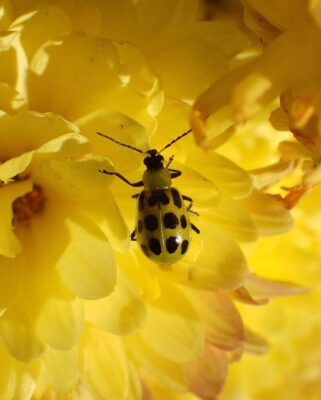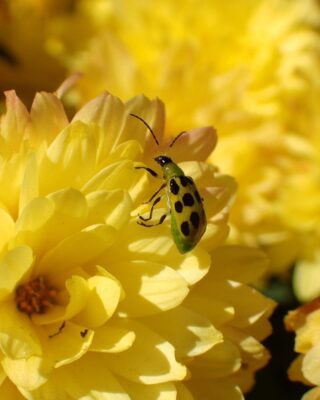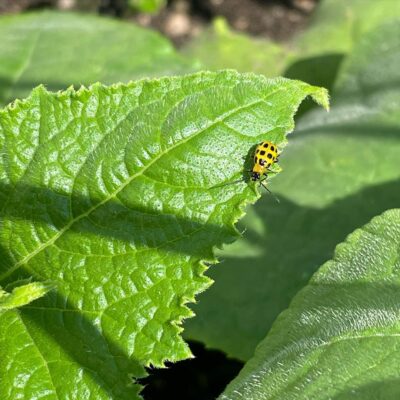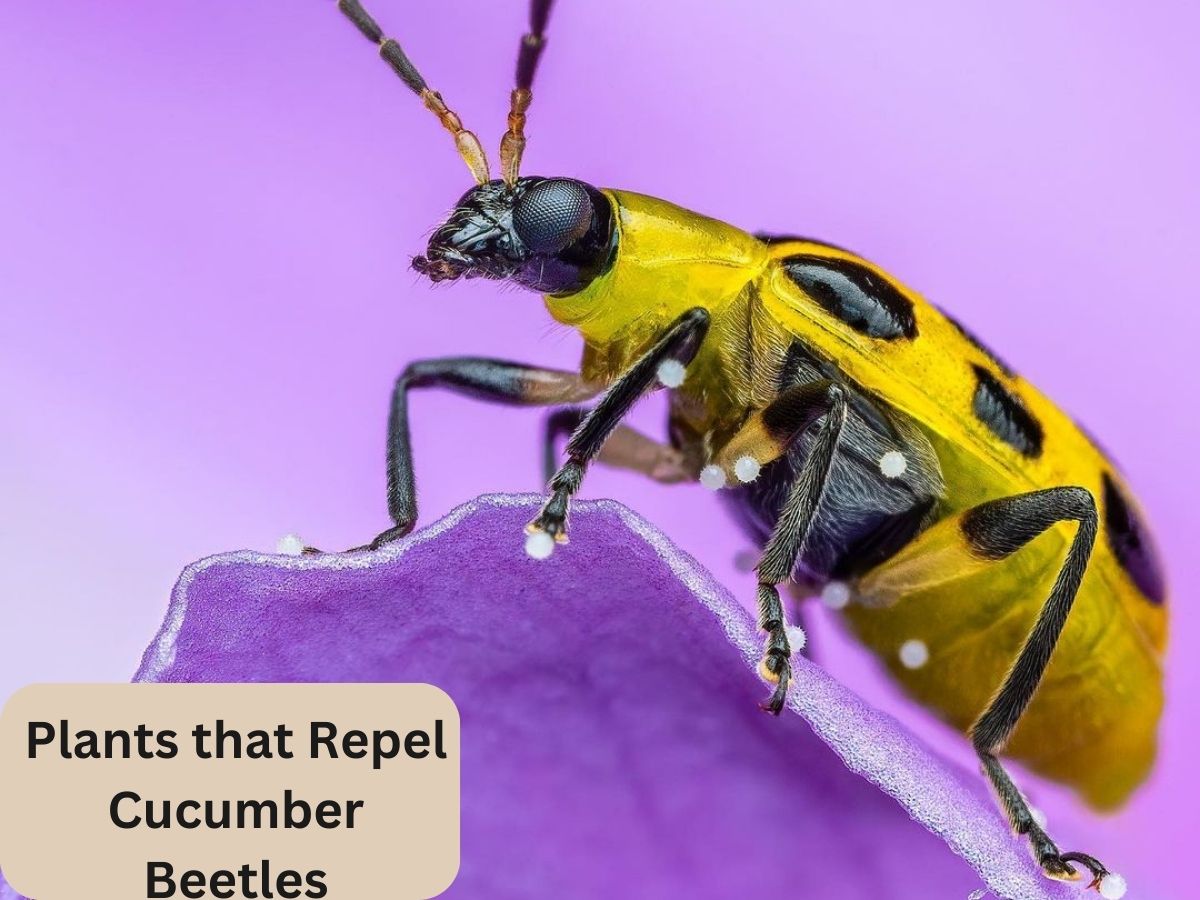Picture a garden where your plants flourish in tranquility, untouched by the persistent nibbling of cucumber beetles. Say hello to your secret defenders: plants that repel cucumber beetles. These natural sentinels hold the key to a harmonious garden, where vibrant growth reigns supreme.
Imagine tansy emitting its robust aroma, steering these beetles away from your precious cucumbers. Visualize the vibrant marigold standing tall, its bright blooms not only adding beauty but also deterring these pests. Nasturtiums, with their vibrant hues, attract not just the eye but also beneficial insects that wage war on the invaders.
But it doesn’t stop there. Lavender’s soothing fragrance and radishes’ clever ploy in diverting attention create a symphony of protection.
These plants aren’t just companions; they’re the guardians of your greens, the keepers of your crops. In this blog, we’ll delve into the world of these botanical heroes, unraveling their secrets and uncovering the art of repelling cucumber beetles naturally. Prepare to transform your garden into an oasis of pest-free prosperity, guided by the wisdom of nature’s defenses.
Understanding Cucumber Beetles
Imagine your vibrant garden, a haven of growth and beauty, is suddenly invaded by the notorious cucumber beetles. These small yet voracious pests, often adorned with yellow and black stripes, may appear innocuous, but their impact can be devastating.
Cucumber beetles are renowned leaf-chewers, leaving behind a trail of destruction as they feast on the foliage of your cucumber, melon, and squash plants. Their insatiable appetite isn’t the only concern – these beetles also carry harmful pathogens that can lead to plant diseases. As they feed, they spread these pathogens, jeopardizing the health of your entire garden.
Early prevention and management are key to averting disaster. These resilient insects can multiply rapidly, so catching them before their numbers explode is essential. By implementing effective strategies, such as companion planting and introducing natural predators, you can minimize the risk of an infestation that could decimate your harvest.
Stay vigilant, for the battle against cucumber beetles begins with understanding their behavior and potential for damage. With the right knowledge and proactive measures, you can protect your garden’s vitality and ensure a thriving, pest-free environment for your plants to flourish.

The Power of Companion Plants
Imagine your garden as a bustling community, where plants interact and support each other in a harmonious dance. This concept, known as companion planting, is nature’s ingenious way of fostering symbiotic relationships among different species. Beyond its aesthetic appeal, companion planting has a powerful role in pest control and overall garden health.
One of the standout benefits of companion planting is its ability to naturally deter pests. Certain plants emit scents, release chemicals, or possess growth habits that repel unwanted insects. These garden warriors act as bodyguards, keeping harmful pests at bay while fostering an environment where beneficial insects can flourish.
Take marigolds, for instance. Their vibrant blooms not only add a splash of color but also emit a scent that cucumber beetles find repulsive. By interspersing marigolds among your vulnerable crops, you create a barrier that the beetles won’t dare to cross. Similarly, radishes release compounds that disrupt the lifecycle of cucumber beetles, effectively thwarting their reproduction.
Companion planting isn’t just about repelling pests, though. It’s about fostering a thriving ecosystem where every plant has a role to play. By strategically pairing plants that complement each other’s growth, you promote soil health, improve pollination, and reduce the need for chemical interventions.
Signs of Cucumber beetles on plant
Cucumber beetles are common pests that can cause damage to cucumber plants and other related crops. There are two main types of cucumber beetles: striped cucumber beetles (Acalymma vittatum) and spotted cucumber beetles (Diabrotica undecimpunctata). Here are some signs of cucumber beetle infestation:
- Leaf Damage: Cucumber beetles feed on the leaves of cucumber plants, causing characteristic damage. They create small holes, pits, and irregularly shaped chewed areas on the leaves. Severe feeding can result in skeletonized leaves, where only the veins remain intact.
- Wilting and Stunted Growth: If cucumber beetle populations are high, they can cause significant damage to the plant’s leaves, leading to wilting, stunted growth, and reduced plant vigor.
- Blossom and Fruit Damage: Cucumber beetles may feed on flowers and developing fruit. This can result in misshapen or scarred fruit and can also contribute to reduced fruit production.
- Yellowing and Discoloration: Feeding damage from cucumber beetles can cause the leaves to turn yellow or brown, affecting the overall appearance of the plant.
- Presence of Beetles: Obviously, the presence of adult cucumber beetles on or around the cucumber plants is a clear sign of infestation. Striped cucumber beetles have distinctive black and yellow stripes, while spotted cucumber beetles are greenish-yellow with 11 black spots on their wings.
- Egg Deposits: Cucumber beetles lay their eggs near the base of plants or in the soil around plant stems. The eggs are small and yellow to orange in color. Checking for egg deposits can help detect an infestation early.
- Root Damage: Some species of cucumber beetles, like the Western cucumber beetle (Diabrotica undecimpunctata howardi), feed on the roots of plants. This can lead to reduced root health and plant stability.
- Transmission of Diseases: Cucumber beetles can also be vectors of bacterial wilt and other plant diseases, which can further damage the plants.
To manage cucumber beetle infestations, consider implementing integrated pest management (IPM) strategies, such as using row covers, applying insecticidal sprays (preferably organic and safe for beneficial insects), rotating crops, and practicing good garden hygiene. Early detection and intervention are key to minimizing the damage caused by cucumber beetles.

Plants That Repel Cucumber Beetles
Cucumber beetles are common pests that can cause damage to cucumbers and other related plants. Using companion planting, which involves strategically planting certain plants to help deter pests, can be an effective way to repel cucumber beetles. Here are some plants that are known to repel cucumber beetles:
Marigolds (Tagetes spp.):
Marigolds are annual flowering plants known for their vibrant hues of yellow, orange, and red. They typically grow to a height of 6 to 36 inches and feature distinctive petals and a pleasant scent. They thrive in full sun and well-drained soil, making them easy additions to any garden.
Marigolds emit a strong fragrance that cucumber beetles find repulsive. The compounds responsible for this scent act as a natural deterrent, keeping these pests away from your garden.
- Incorporation Tips: Plant marigolds around the perimeter of your garden beds or as a border between susceptible plants. They not only add a pop of color but also serve as a barrier against cucumber beetles.
Radishes:
Radishes are cool-season root vegetables with edible leaves and crisp, peppery-flavored bulbs. They are fast growers and typically reach maturity within a few weeks.They thrive in cooler weather and require well-drained soil.
Radishes release sulfur compounds into the soil as they grow, and these compounds disrupt the life cycle of cucumber beetles. By interfering with the pests’ reproduction, radishes naturally discourage cucumber beetle populations.
- Incorporation Tips: Plant radishes alongside your cucumber, melon, and squash plants. Their quick growth and natural repellent properties make them an effective early defense against cucumber beetles.
Nasturtiums (Tropaeolum majus):
Nasturtiums are trailing or bushy annual plants with distinctive round leaves and vibrant flowers in shades of yellow, orange, and red. Both the leaves and flowers are edible and have a peppery flavor. They have distinctive rounded leaves and trailing stems.
Nasturtiums produce a peppery scent that cucumber beetles find disagreeable. This aroma acts as a deterrent, discouraging the pests from approaching the plants.
- Incorporation Tips: Plant nasturtiums as companion plants near your cucumber, melon, and squash beds. Their sprawling nature can provide ground cover and a barrier against cucumber beetles. Additionally, the flowers and leaves can be used to add a unique twist to salads and dishes.
Tansy (Tanacetum vulgare):
Tansy is a perennial herb with fern-like leaves and clusters of yellow button-like flowers. It can grow up to 3 feet in height and has a strong, distinctive aroma.
Tansy contains compounds like thujone and camphor that emit a strong scent. This scent is unappealing to cucumber beetles, making tansy an effective natural repellent.
- Incorporation Tips: Plant tansy around the borders of your cucumber, melon, and squash beds. However, exercise caution, as tansy can become invasive if not managed. Its robust growth and repellent properties make it a valuable addition to your pest management strategy.
Catnip (Nepeta cataria):
Catnip is a perennial herb with serrated leaves and small, lavender-hued flowers. It’s known for its aromatic oils that attract cats.
While beloved by cats, catnip’s scent is displeasing to cucumber beetles. The natural compounds in catnip act as a repellent, keeping these pests away from your garden.
- Incorporation Tips: Plant catnip in containers near your susceptible crops or in designated areas of your garden. Not only will catnip deter cucumber beetles, but it will also provide a playful distraction for your feline friends.
Chrysanthemums (Chrysanthemum spp.):
Chrysanthemums, commonly known as mums, are flowering perennials available in various colors and forms. They range from daisy-like to pom-pom blooms.
Chrysanthemums contain natural insecticidal compounds called pyrethrins. These compounds are commonly used in commercial insect repellents. Chrysanthemums’ presence can deter cucumber beetles and other unwanted insects.
- Incorporation Tips: Plant chrysanthemums around the perimeter of your garden or near your cucumber, melon, and squash plants. Not only do they add aesthetic appeal, but they also provide a powerful defense against pests.
Garlic (Allium sativum):
Garlic is a bulbous plant with long, flat leaves and a distinctive, pungent aroma. It’s a staple in many cuisines and has been used for its medicinal properties for centuries. Here is a detailed guide on how to grow garlic successfully in your garden.
The strong odor of garlic is unappealing to cucumber beetles. When planted near susceptible crops, garlic acts as a natural deterrent, reducing the likelihood of infestations.
- Incorporation Tips: Plant garlic around the borders of your garden beds or within your cucumber, melon, and squash patches. Not only does garlic repel cucumber beetles, but you’ll also have a fresh supply of this versatile ingredient for your kitchen.
Rue (Ruta graveolens):
Rue is a hardy perennial herb with blue-green leaves and small, yellow flowers. It has a strong scent and has historically been used for its potential medicinal benefits.
Rue emits a powerful aroma that cucumber beetles find displeasing. Its scent serves as a natural deterrent, discouraging these pests from infesting your garden.
- Incorporation Tips: Plant rue strategically around your cucumber, melon, and squash plants. However, exercise caution when handling rue, as it can cause skin irritation in some individuals. Use gloves and proper care during planting and maintenance.
Pyrethrum (Chrysanthemum cinerariifolium):
Pyrethrum, also known as Dalmatian chrysanthemum, is a perennial plant with daisy-like flowers and finely divided leaves. It’s known for its insecticidal properties.
Pyrethrum contains natural insecticidal compounds called pyrethrins. These compounds repel cucumber beetles and other pests, making pyrethrum a formidable defense.
- Incorporation Tips: Plant pyrethrum as a border around your susceptible crops or in clusters within your garden. Its insecticidal properties will help keep cucumber beetles at bay while adding visual interest to your garden beds.
Garlic Chives (Allium tuberosum):
Garlic chives, also known as Chinese chives, are a perennial herb with thin, flat leaves and delicate white flowers. They belong to the onion family and have a mild garlic flavor.
Much like garlic, garlic chives emit a pungent aroma that repels cucumber beetles. The scent acts as a natural deterrent, reducing the likelihood of infestations.
- Incorporation Tips: Plant garlic chives near your susceptible crops or along garden pathways. Their mild garlic flavor makes them a culinary delight, and their pest-repelling properties are a bonus.
Petunias (Petunia spp.):
Petunias are popular annual flowering plants available in a variety of colors, shapes, and sizes. They are well-loved for their trumpet-shaped blooms and vibrant appearance.
Petunias emit a fragrance that cucumber beetles find displeasing. This scent serves as a natural repellent, helping to protect your garden from infestations.
- Incorporation Tips: Plant petunias in hanging baskets, containers, or along the borders of your garden beds. They not only add visual appeal but also create a fragrant barrier against cucumber beetles.
Lavender (Lavandula spp.):
Lavender is a fragrant perennial herb with narrow leaves and distinctive spikes of purple flowers. It’s well-known for its calming aroma and ornamental value. Grow you levenda successfully with this guide.
Lavender’s soothing scent is beloved by humans but repels cucumber beetles. The aromatic compounds in the lavender act as a natural deterrent, keeping these pests at bay.
- Incorporation Tips: Plant lavender near your cucumber, melon, and squash plants, or intersperse it among your garden beds. Its aromatic presence will not only fend off pests but also enhance the atmosphere of your garden.

Plants that repel cucumber beetles FAQs?
Do cucumber beetles harm all types of plants?
While cucumber beetles primarily target plants in the cucurbit family, including cucumbers, squash, melons, and pumpkins, they can also damage other plants to some extent.
These beetles are known to feed on the foliage, flowers, and fruits of a variety of crops, causing aesthetic damage, reduced yield, and even transmitting diseases. However, their impact varies depending on the plant species, local environmental conditions, and the population of cucumber beetles in the area.
How do companion plants disrupt the cucumber beetle lifecycle?
Companion plants play a vital role in disrupting the cucumber beetle lifecycle through several mechanisms:
- Aromatic Defense: Plants like tansy, lavender, and marigold emit strong fragrances that repel cucumber beetles, making the area less appealing to them.
- Trap Crops: Radishes are considered trap crops because cucumber beetles are naturally drawn to them. By planting radishes near your main crops, you can divert the beetles away from your precious plants.
- Beneficial Insects: Nasturtiums attract beneficial insects like ladybugs and parasitic wasps that prey on cucumber beetles and their larvae.
Are there other ways to control cucumber beetles?
Yes, there are alternative methods to control cucumber beetles:
- Physical Barriers: Using floating row covers can prevent adult cucumber beetles from reaching your plants and laying eggs.
- Handpicking: While labor-intensive, physically removing beetles from your plants can help reduce their population.
- Cultural Practices: Implementing good garden hygiene, such as removing debris and weeds that could harbor beetles, can discourage their presence.
Can I mix multiple repellent plants?
Absolutely! Mixing different repellent plants together can create a synergistic effect, enhancing the overall protection of your garden. For instance, planting tansy, marigold, and nasturtiums in close proximity can create a diverse barrier of scents and colors that help deter cucumber beetles and other pests. Just ensure that you consider the growth habits and spacing requirements of each plant to prevent overcrowding and competition for resources.
Implementing Your Cucumber Beetle Defense:
Cucumber beetles can be quite damaging to plants, especially cucurbit crops like cucumbers, squash, and melons. Here are some steps you can take to defend your plants against cucumber beetles:
Designing a Companion Planting Layout
- Choose Your Repellent Plants: Decide which repellent plants you’d like to include in your garden. Consider a mix of tansy, nasturtium, radishes, marigold, and lavender for a diverse and effective defense.
- Understand Plant Requirements: Research the sunlight, water, and soil preferences of each plant. Group those with similar needs together to ensure optimal growth.
- Plan for Plant Spacing: Companion plants should be strategically placed to cover the area where cucumber beetles are likely to visit. Create clusters or rows of these plants around your main crops.
Planting and Care
- Prepare the Soil: Ensure the soil is well-draining and amended with organic matter before planting. This provides a healthy foundation for your repellent plants to thrive.
- Planting: Follow the recommended spacing guidelines for each plant. Plant taller varieties like tansy and marigold towards the back and shorter ones like nasturtiums and radishes towards the front.
- Mulching: Apply a layer of organic mulch around your companion plants. Mulch helps retain soil moisture, suppress weeds, and create a favorable environment for plant growth.
- Watering: Water your plants regularly, keeping the soil consistently moist but not waterlogged. Be mindful of the specific water needs of each plant.
Care and Maintenance
- Fertilization: Depending on the plant’s requirements, apply a balanced, slow-release fertilizer once a month during the growing season. Avoid over-fertilization, as it can lead to excessive foliage growth.
- Pruning: Regularly remove any dead or diseased leaves to prevent the spread of pests and diseases. Pruning also helps maintain air circulation within the plant canopy.
- Deadheading: For plants like marigolds and nasturtium, deadhead (remove spent flowers) to encourage continuous blooming and discourage pests from congregating around faded blooms.
Monitoring for Signs of Cucumber Beetles
- Routine Inspections: Regularly inspect your plants for any signs of cucumber beetles. Pay close attention to the underside of leaves, where they often hide.
- Handpicking: If you spot cucumber beetles, consider handpicking them and dropping them into a bucket of soapy water. This can help reduce their population.
- Sticky Traps: Place yellow sticky traps near your companion plants to catch adult cucumber beetles and monitor their activity levels.
- Nurturing Beneficial Insects: By creating a diverse garden ecosystem, you can attract natural predators like ladybugs and parasitic wasps that help control cucumber beetle populations.
Conclusion
Harnessing the power of nature’s guardians against cucumber beetles through companion planting offers a holistic and eco-friendly approach to safeguarding your garden. By strategically incorporating repellent plants like tansy, nasturtium, radishes, marigold, and lavender, you create a dynamic barrier that deters these pesky pests.
Beyond their aromatic charm, these plants disrupt the cucumber beetle lifecycle by repelling adults, attracting beneficial insects, and even luring beetles away from your main crops. This natural defense strategy not only protects your cucumbers and other vulnerable plants but also fosters a harmonious garden ecosystem.
With careful planning, proper care, and consistent monitoring, your garden becomes a haven where the battle against cucumber beetles is fought with nature’s elegance. Embrace this sustainable solution, and let your garden thrive as a sanctuary of balance and beauty, where plants and insects coexist in harmony.
